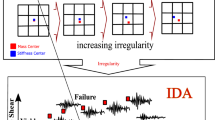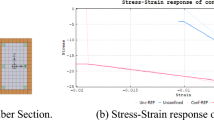Abstract
A controlled rocking concentrically steel braced frame (CR-CSBF) is introduced as an alternative to conventional methods to prevent major structural damage during large earthquakes. It is equipped with elastic post-tensioned (PT) cables and replaceable devices or fuses to provide overturning resistance and dissipate energy, respectively. Although CR-CSBFs are not officially legalized in globally valid codes for new buildings, it is expected to be presented in them in the near future. The main goal of this study is to determine the optimal design parameters consist of the yield strength and modulus of elasticity of the fuse, the initial force of the PT cable, and the gravity load on the rocking column, considering different heights of the frame, spanning ratios and ground motion types for dual-configuration CR-CSBF. Nonlinear time-history analyses are performed in OpenSees. This study aims to define the optimal input variables as effective design parameters of CR-CSBFs by comparing four seismic responses consisting of story drift, roof displacement, roof acceleration and base shear, and also using the Euclidean metric optimization method. Despite the previous research, this study is innovative and first of its kind. The results demonstrate that the optimal design parameters are variable for various conditions.
Similar content being viewed by others
References
Ajrab JJ, Pekcan G and Mander JB (2004), “Rocking Wall-Frame Structures with Supplemental Tendon Systems”, Journal of Structural Engineering, 130(6): 895–903.
ASCE/SEI 7–16 2016, Minimum Design Loads and Associated Criteria for Buildings and Other Structures, American Society of Civil Engineers, Reston, Virginia, USA.
Buchanan A, Deam B, Fragiacomo M, Pampanin S and Palermo A (2008), “Multi-Storey Prestressed Timber Buildings in New Zealand”, Structural Engineering International, 18(2): 166–173.
Clough RW and Huckelbridge AA (1977), “Preliminary Experimental Study of Seismic Uplift of a Steel Frame”, Earthquake Engineering Research Center Report No. UCB/EERC77-22, University of California, Berkeley, California, USA.
Deza MM and Deza E 2016, Encyclopedia of Distances, Fourth Edition, Springer-Verlag, Berlin Heidelberg, Germany.
Eatherton MR and Hajjar JF (2010), “Large-Scale Cyclic and Hybrid Simulation Testing and Development of a Controlled-Rocking Steel Building System with Replaceable Fuses”, PhD Dissertation, Newmark Structural Engineering Laboratory, University of Illinois at Urbana-Champaign, Champaign, IL, USA.
Eatherton MR, Hajjar JF, Deierlein G, Krawinkler H, Billington S and Ma X (2008), “Controlled Rocking of Steel-Framed Buildings with Replaceable Energy-Dissipating Fuses,” Proc. of the 14th World Conference on Earthquake Engineering, Beijing, China.
Eatherton MR, Ma X, Krawinkler H, Mar D, Billington S, Hajjar JF and Deierlein GG (2014), “Design Concepts for Controlled Rocking of Self-Centering Steel-Braced Frames”, Journal of Structural Engineering, 140(11): 195–203.
FEMA P695 2009, Quantification of Building Seismic Performance Factors, Federal Emergency Management Agency, Redwood City, CA, USA.
Francesco S, Palermo A and Pampanin S (2015), “Quasi-Static Cyclic Testing of Two-Thirds Scale Unbonded Posttensioned Rocking Dissipative Timber Walls”, Journal of Structural Engineering, 142(4): E4015005.
Ghasemi S, Nezamabadi MF, Moghadam AS and Hosseini M (2021), “Optimization of Relative-Span Ratio in Rocking Steel Braced Dual-Frames”, Bulletin of Earthquake Engineering, 19(2): 805–829.
Grigorian C and Grigorian M (2015a), “Performance Control and Efficient Design of Rocking-Wall Moment Frames”, Journal of Structural Engineering, 142(2): 04015139.
Grigorian M and Grigorian C (2015b), “An Introduction to the Structural Design of Rocking Wall-Frames with a View to Collapse Prevention, Self-Alignment and Repairability”, The Structural Design of Tall and Special Buildings, 25(2): 93–111.
Hosseini M, Fekri M and Yekrangnia M (2016), “Seismic Performance of an Innovative Structural System Having Seesaw Motion and Columns Equipped with Friction Dampers at Base Level”, The Structural Design of Tall and Special Buildings, 25(16): 842–865.
Housner GW (1963), “The Behavior of Inverted Pendulum Structures During Earthquakes”, Bulletin of the Seismological Society of America, 53(2): 403–417.
International Building Code, IBC 2018, International Code Council, INC, IBC ICC, Country Club Hills, IL, USA.
Iwashita K, Kimura H, Kasuga Y and Suzuki N (2002), “Shaking Table Test of a Steel Frame Allowing Uplift”, Journal of Structural and Construction Engineering, 67(561): 47–54.
Kelly J and Tsztoo D (1977), “Earthquake Simulation Testing of a Stepping Frame with Energy-Absorbing Devices”, Report No. EERC77-17, Earthquake Engineering Research Center, University of California, Berkeley, CA, USA.
Khanmohammadi M and Mohsenzadeh V (2018), “Effects of Foundation Rocking and Uplifting on Displacement Amplification Factor”, Earthquake Engineering and Engineering Vibration, 17(3): 511–525.
Latham DA, Reay AM and Pampanin S (2013), “Kilmore Street Medical Centre: Application of an Advanced Flag-Shape Steel Rocking System,” Proc. of the NZSEE Conference, Wellington, New Zealand.
Ma X, Borchers E, Pena A, Krawinkler H, Billingto S and Deierlein G (2010a), “Design and Behavior of Steel Shear Plates with Openings as Energy-Dissipating Fuses”, Technical Report 173, John A. Blume Earthquake Engineering Center, Stanford University, Stanford, CA, USA.
Ma X, Eatherton M, Hajjar J, Krawinkler H and Deierlein G (2010b), “Seismic Design and Behavior of Steel Frames with Controlled Rocking: Part II — Large Scale Shake Table Testing and System Collapse Analysis,” Proc. of the Structures Congress, Orlando, FL, USA.
Ma X, Krawinkler H and Deierlein G (2011), “Seismic Design and Behavior of Self-Centering Braced Frame with Controlled Rocking and Energy Dissipating Fuses”, Technical Report 174, John A. Blume Earthquake Engineering Center, Stanford University, Stanford, CA, USA.
Moradi S, Alam M and Milani A (2015), “Cyclic Response Sensitivity of Posttensioned Steel Connections Using Sequential Fractional Factorial Design”, Journal of Constructional Steel Research, 112(1): 155–166.
Moradi S and Burton HV (2018), “Response Surface Analysis and Optimization of Controlled Rocking Steel Braced Frames”, Bulletin of Earthquake Engineering, 16(10): 4861–4892.
OpenSees Version 2.4.6 2015, Open System for Earthquake Engineering Simulation, Pacific Earthquake Engineering Research Center, University of California, USA.
Pan P, Wu SJ, Wang HS and Nie X (2018), “Seismic Performance Evaluation of an Infilled Rocking Wall Frame Structure Through Quasi-Static Cyclic Testing”, Earthquake Engineering and Engineering Vibration, 17(2): 371–383.
Pollino M and Bruneau M (2010), “Seismic Testing of a Bridge Steel Truss Pier Designed for Controlled Rocking”, Journal of Structural Engineering, 136(12): 1523–1532.
Rahgozar N and Rahgozar N (2020), “Extension of Direct Displacement-Based Design for Quantifying Higher Mode Effects on Controlled Rocking Steel Cores”, The Structural Design of Tall and Special Buildings, 29(16): e1800.
Rahgozar N, Moghadam AS and Aziminejad A (2016), “Quantification of Seismic Performance Factors for Self-Centering Controlled Rocking Special Concentrically Braced Frame”, The Structural Design of Tall and Special Buildings, 25(14): 700–723.
Roke D, Sause R, Ricles JM and Gonner N (2008), “Design Concepts for Damage-Free Seismic-Resistant Self-Centering Steel Concentrically-Braced Frames,” Proc. of the 14th World Conference on Earthquake Engineering, Beijing, China.
Salkind NJ 2010, Encyclopedia of Research Design, University of Kansas, SAGE Publications, UK.
Sause R, Ricles JM, Roke DA, Chancellor NB and Gonner NP (2010), “Seismic Performance of a Self-Centering Rocking Concentrically-Braced Frame,” Proc. of the 9th US and 10th Canadian Conference on Earthquake Engineering, Toronto, ON, Canada.
Sause R, Ricles JM, Roke D, Seo CY and Lee KS (2006), “Design of Self-Centering Steel Concentrically-Braced Frames,” Proc. of the 4th International Conference on Earthquake Engineering, Taipei, China.
Smith T, Ludwig F, Pampanin S, Fragiacomo M, Buchanan A, Deam B and Palermo A (2007), “Seismic Response of Hybrid-LVL Coupled Walls Under Quasi-Static and Pseudo-Dynamic Testing,” New Zealand Society for Earthquake Engineering Conference, Palmerston North, New Zealand.
Tahmasebi E, Sause R, Ricles JM, Chancellor NB and Akbas T (2014), “Probabilistic Collapse Performance Assessment of Self-Centering Concentrically Braced Frames,” Proc. of the 10th US National Conference on Earthquake Engineering, Anchorage, AK, USA.
Toranzo LA, Restrepo JI, Mander JB and Carr AJ (2009), “Shake-Table Tests of Confined-Masonry Rocking Walls with Supplementary Hysteretic Damping”, Journal of Earthquake Engineering, 13(6): 882–898.
Wiebe L and Christopoulos C (2015), “Performance-Based Seismic Design of Controlled Rocking Steel Braced Frames. I: Methodological Framework and Design of Base Rocking Joint”, Journal of Structural Engineering, 141(9): 04014226.
Wiebe L, Christopoulos C, Tremblay R and Leclerc M (2013 a), “Mechanisms to Limit Higher Mode Effects in a Controlled Rocking Steel Frame. 1: Concept, Modelling, and Low-Amplitude Shake Table Testing”, Earthquake Engineering Structural Dynamics, 42(7): 1053–1068.
Wiebe L, Christopoulos C, Tremblay R and Leclerc M (2013b), “Mechanisms to Limit Higher Mode Effects in a Controlled Rocking Steel Frame. 2: Large-Amplitude Shake Table Testing”, Earthquake Engineering Structural Dynamics, 42(7): 1069–1086.
Zhang Y and Hu X (2010), “Self-Centering Seismic Retrofit Scheme for Reinforced Concrete Frame Structures: SDOF System Study”, Earthquake Engineering and Engineering Vibration, 9(2): 271–283.
Author information
Authors and Affiliations
Corresponding author
Rights and permissions
About this article
Cite this article
Ghasemi, S., Nezamabadi, M.F., Moghadam, A.S. et al. Optimization of design parameters for controlled rocking steel braced dual-frames. Earthq. Eng. Eng. Vib. 21, 1053–1068 (2022). https://doi.org/10.1007/s11803-022-2134-z
Received:
Accepted:
Published:
Issue Date:
DOI: https://doi.org/10.1007/s11803-022-2134-z




